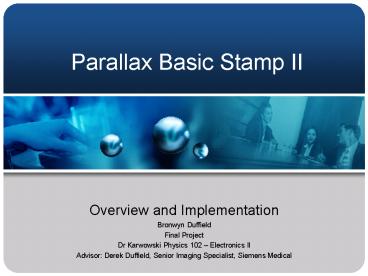Parallax Basic Stamp II PowerPoint PPT Presentation
Title: Parallax Basic Stamp II
1
Parallax Basic Stamp II
- Overview and Implementation
- Bronwyn Duffield
- Final Project
- Dr Karwowski Physics 102 Electronics II
- Advisor Derek Duffield, Senior Imaging
Specialist, Siemens Medical
2
Overview
1. BS2 Overview and Introduction to my Project
2. Heart Disease problem
3. Project Proposal and Progress
4. Results and Difficulties
5. Costs and Future Plans
6. Acknowledgements
3
What is it, and why do I care?
The BASIC Stamp II, made by Parallax is a
single-board computer that runs a language called
PBASIC.
More advanced commands let the Stamp
interface with other integrated circuits,
communicate with each other, and operate in
Networks.
The BS2 language is easy to comprehend.
The BASIC Stamp has prospered in hobby,
lower-volume engineering projects and education
due to ease of use and a wide support base of
free application resources.
4
More on the Basic Stamp II
Advantages of the Basic Stamp II
Ability to interface with GUIs such as LabVIEW
Relatively Inexpensive
Very easy to use and understand
Small/Compact
Tons of information available
5
BS2 Software and Hardware
Processor Speed 20 MHz
Program Execution Speed 4,000 instructions/sec
Ram Size 32 Bytes (6 I/O, 26 VAR)
EEPROM (Program) Size 2K Bytes, 500 instruc.
I/O Pins 16 2 dedicated serial
Voltage Requirements 5-15 VDC
Current Draw at 5V 3 mA Run/50 µA Sleep
PBASIC Commands 42
Size 1.2x0.6x0.4
6
Example BS2 Program
7
Problem
- In 2002 a total of 2,443,387 deaths occurred in
the United States. - The age-adjusted death rate, which eliminates the
effects of the aging of the population, was 845.3
deaths per 100,000 U.S. standard population. - Heart disease and cancer continued to be the
leading and second leading causes of death,
together accounting for over half of all deaths.
8
Project Proposal
- By incorporating specialized hardware and
software into cardiac examinations, death can be
prevented. - The overall goal of the project to provide a
software program that is able to show
Freeze-Framed Images of the Heart that are
synchronized with the patients actual heartbeat. - The Physician will be able to specify times that
correlate to certain components of the patients
heart beat, those pulses from the GUI will then
be sent to an X-Ray machine. - The benefit of synchronizing X-Ray images of the
heart with the patients heart beat is that
Physicians will be able to see the heart, and any
defects, at a much slower rate. Therefore,
details that before would have gone unnoticed,
will be easily identified. - Unfortunately, due to time constraints, we were
unable to finish the second part of the project.
We plan to work more in the future.
9
Part 1 ECG Monitor
- This part of the project included using a ECG
simulator to produce a patients heartbeat,
amplify the signal through Signal Processing, use
the BASIC Stamp II to input the signal, acquire
the signal in LabVIEW, and then display the Heart
Rate in beats per minute (BPM). - I used a serial cable to send and receive the
data. Therefore, the data I received in LabVIEW
was in the form of a string of ASCII characters. - The BASIC Stamp II Homework Board was used
instead of the Board of Education BASIC Stamp II.
This was due to cost restrictions.
10
Progress Diagram
Phase 1
Phase 2
Phase 3
Incorporate LabVIEW
Learn the PBASIC Programming Language and plan
project.
Design and build the ECG Monitor and Implement
the BS2
11
Project Proposal
ECG Simulator
Signal Processing
BS2 Program
Monitored Hear Rate
A program written in the BS2 programming language
PBASIC is used to configure the board.
The signal, however, is very difficult to read.
Therefore, some signal conditioning needed to be
done.
The amplified signal is acquired using the BS2
and s serial com port and the heart rate is
displayed in a graphical user interface.
An ECG Simulator produces a heartbeat at a
certain frequency that can be measured.
12
ECG Monitor Schematics
13
Results and Difficulties
- Difficulties
- One of the biggest difficulties was receiving
data in LabVIEW through a serial port. - Learning the programming language, PBASIC, was
simple. However, interfacing it with LabVIEW was
more difficult. - Lack of equipment prevented the display of the
simulated heartbeat in LabVIEW. However, the ECG
amplifier was tested using the Oscilloscope and
proved successful. - Results
- I successfully displayed the BPM in LabVIEW
using serial communications. - The ECG Amplifier successfully amplified the
simulated signal. - I programmed the BASIC Stamp II to switch an LED
on and off when the input signal was high and
low. By analyzing the signal for peaks, one can
determine the heart rate of a patient.
14
Costs
Cost
BASIC Stamp II Homework Board Kit 69.00
RS-232 Serial Cable 40.00
LabVIEW Student Version 80.00
15
Future Plans over the Summer
Display the image in a GUI
Research image processing techniques
Synchronize a simulated heartbeat with the X-Ray
machine
BE LAZY!!
Implement the LV Heart Monitor With a DAQ
X-Ray simulator
Research LabVIEWs Imaging Capabilities
16
Acknowledgements
I would like to thank
Of coarse, my father, for introducing
many interesting aspects of his field of
expertise.
Id like to thank Dr. Karwowski for this
opportunity.
Lastly, I would like to Thank everyone in class
for your attention.
My mother, for putting up with all the
electronics and wires covering her house.

